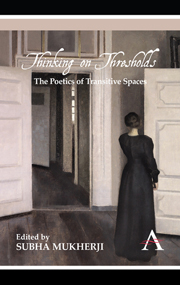Book contents
- Frontmatter
- ACKNOWLEDGEMENTS
- Contents
- List of Illustrations
- Notes on Contributors
- Introduction
- Part One Doors, Windows, Entries
- Part Two Lives and Narratives, Territories and Worlds
- 5 Unsettling Thresholds: Mignon and Her Afterlives
- 6 Dangerous Liaisons: Desire and Limit in The Home and the World
- 7 Writing Through Osmotic Borders: Boundaries, Liminality and Language in Mehmet Yashin's Poetics
- 8 Dancing and Romancing: The Obstacle of the Beach and the Threshold of the Past
- Part Three Matter, Mind, Psyche
- Part Four Reading, Writing, Playing, Listening
- Select Bibliography (including Discography)
6 - Dangerous Liaisons: Desire and Limit in The Home and the World
from Part Two - Lives and Narratives, Territories and Worlds
Published online by Cambridge University Press: 05 March 2012
- Frontmatter
- ACKNOWLEDGEMENTS
- Contents
- List of Illustrations
- Notes on Contributors
- Introduction
- Part One Doors, Windows, Entries
- Part Two Lives and Narratives, Territories and Worlds
- 5 Unsettling Thresholds: Mignon and Her Afterlives
- 6 Dangerous Liaisons: Desire and Limit in The Home and the World
- 7 Writing Through Osmotic Borders: Boundaries, Liminality and Language in Mehmet Yashin's Poetics
- 8 Dancing and Romancing: The Obstacle of the Beach and the Threshold of the Past
- Part Three Matter, Mind, Psyche
- Part Four Reading, Writing, Playing, Listening
- Select Bibliography (including Discography)
Summary
A threshold is physically crossed in one of the most striking visual sequences in Satyajit Ray's 1984 film, Ghare Baire (The Home and the World). It is a cinematic moment filled with expectation, prefaced by the narratorial voice of the film's protagonist, Bimala. On this day, we learn, the 12th of Agrahayan, B.S. 1314 (26 November 1907), the young mistress of the zamindari of Sukhsayar, for the first time in the family's history, stepped out of the inner, women's quarters (the andarmahal) of the house to entertain a guest in its outer apartments.
The diegetic framing of the sequence appears to cite the film's own framing by a literary text, Rabindranath Tagore's novel of the same name (serialised 1915–16). But this is an illusion. The moment itself belongs entirely to the film's field of vision; it is missing in the novel, which contains no textual counterpart to Bimala's voiced commentary. With the exception of that voice, the sequence is silent. The pale green doors of the andarmahal swing open, and two graceful, formally-dressed figures – Bimala and her husband Nikhilesh – emerge into a light-filled gallery. The camera's eye focuses for a moment on the pair's feet, shod in decorative slippers, then moves up to track their transit through the corridor, panelled in stained glass that casts an unearthly radiance on the scene. As they reach the open doors at its end and emerge into the long, pillared verandah, with its slender European statues on raised pediments, the pace diminishes to lyrical slow motion.
- Type
- Chapter
- Information
- Thinking on ThresholdsThe Poetics of Transitive Spaces, pp. 87 - 100Publisher: Anthem PressPrint publication year: 2011



